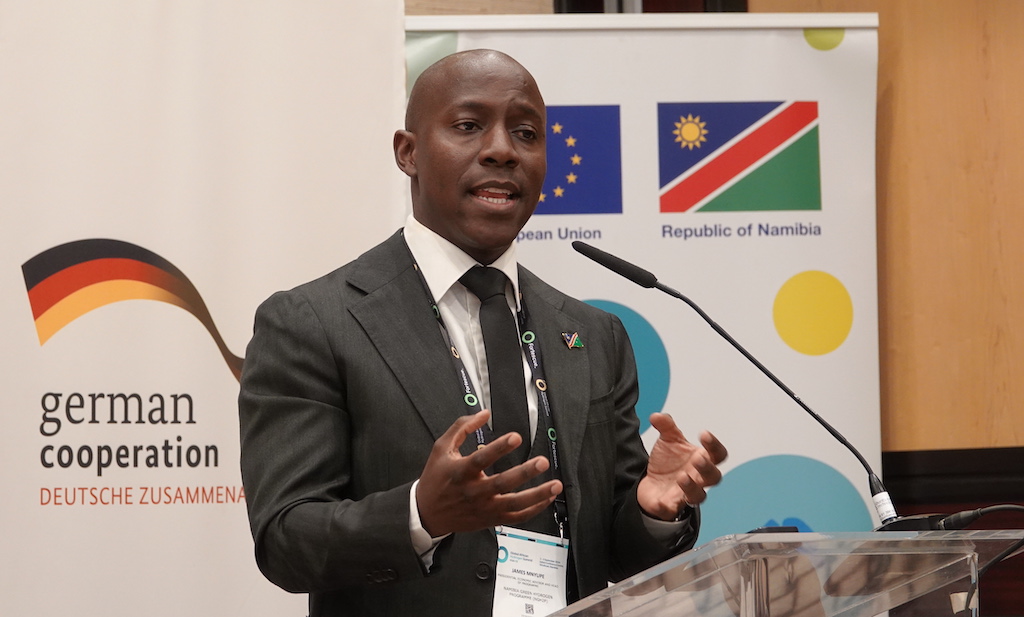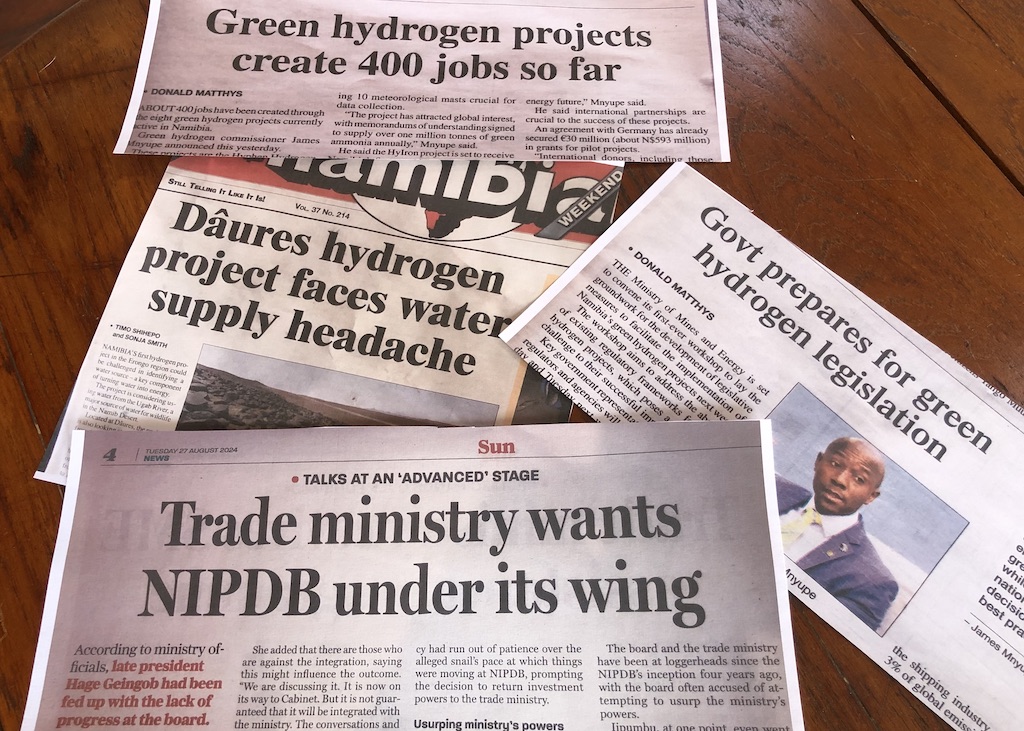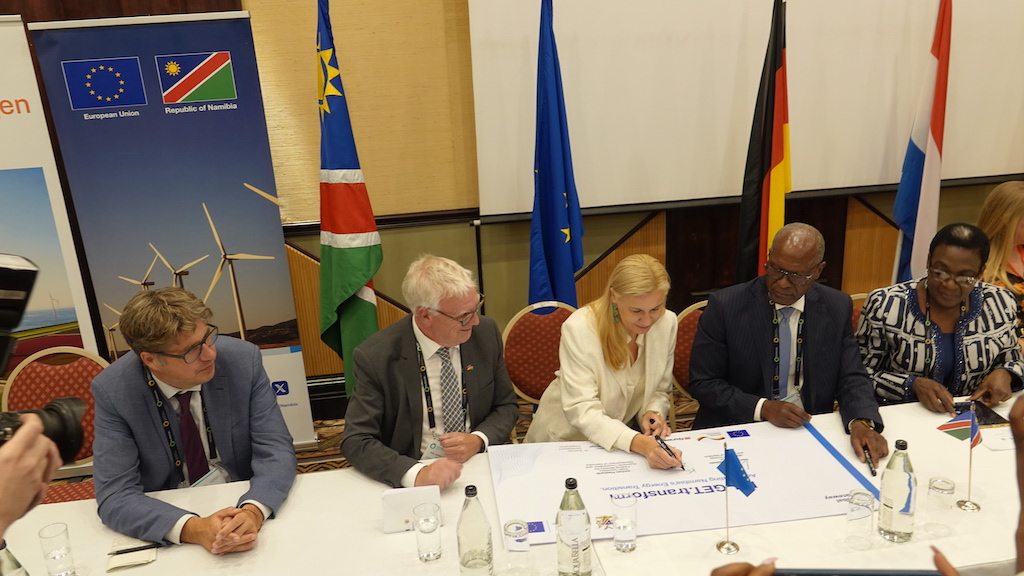
Minister of Mines and Energy Tom Alweendo, cautioning at the summit that overly-optimistic predictions of up to 250,000 jobs by 2030 may not be realistic but what mattered was the establishing of a new type of industry that he termed the second industrialisation revolution. Photo: John Grobler
John Grobler takes stock of progress on Namibia’s ambitious green hydrogen programme.
The Namibian government hosted the Global African Hydrogen Summit in Windhoek from September 3 to 5, but the reality on the ground outside the conference halls is that not a single kilogramme of green hydrogen or ammonia has yet been produced in the country – despite official ambitions to produce at least 300,000 tons of green ammonia for the export market by 2030.
Three years after the government issued an international request for green hydrogen (GH2) proposals in June 2021, three of the nine projects approved so far say are about to go into production by the end of 2024. Cleanergy, HyIron and Daures Green Village have all confirmed that they are in the final phases of their respective first-phase pilot projects.
While the lack of local GH2 production is ascribed by experts to a world-wide shortage of electroliser units, the majority of proposed GH2 projects are lagging behind schedule due to a combination of factors ranging from a lack of infrastructure and water to struggling to attract private equity investment.

Green Hydrogen Commissioner James Mnyupe, whose statutory position is yet to be affirmed by the long-overdue green hydrogen legislation being drafted by the Electricity Control Board, or the gazetting of the Namibia Investments Promotions and Marketing Board as an independent state-owned enterprise. Photo: John Grobler
Stumbling blocks
One of the stumbling blocks is the lack of a legal framework, with a draft Green Hydrogen Bill under development by the Electricity Control Board since last year yet to be tabled in Parliament.
Furthermore, the Namibia Investment Promotion and Development Board (NIPDB) that was set up in the Office of the President in January 2021 as executive implementing agency of the green economy plans is yet to be formally gazetted by the Ministry of Finance.
That implies the statutory position of the Green Hydrogen Commissioner James Mnyupe, appointed by the late President Hage Geingob in August 2020, is technically still legally invalid.
This legal imbroglio appears to be related to an internal political power struggle within senior government ranks over who would have final authority under the controversial new Namibia Investments Promotions Act that would dictate to foreign investors what sectors they are allowed to invest in and who they are to choose as local black economic empowerment (BEE) partners.
As matters stand at present, the Ministry of Industrialisation, Trade and SME Development still legally has jurisdiction over what used to be the ministry’s Investment Centre before Geingob had moved that function into the Office of the President, NIPDB’s strategic marketing and branding manager Catherine Shipushu confirmed.
Mnyupe had not responded to questions regarding these issues that were emailed to his address at the Office of the President on Friday, 6 September.
The NIPDB also could not provide a full list of all currently promoted GH2 projects, saying these companies were not obliged to register with them and that only Hyphen Hydrogen had done so thus far.

The challenges faced by the Namibian green economy: a lack of water, bureaucratic power struggles, slow progress in drafting GH2 legislation and a disappointing amount of new jobs after three years of Namibia’s adopting the GH2 economy approach. Photo: John Grobler
Political momentum
Since Geingob’s death in early February, the official marketing drive for what was intended to be his economic legacy has noticeably started losing political momentum in the face of rising public scepticism over the green economy’s feasibility, practicality and environmental impacts on the fragile ecology of the Namib Desert.
The NIPDB has been quietly dialling back the GH2 programme’s ambitions to attract US$190-billion in foreign investments over the next 10 years in mining, manufacturing and agriculture projects planned for the northern, central and southern Green Hydrogen Corridors extending from the Atlantic coastline.
Hyphen Hydrogen Energy, after first acting as adviser to the NIPDB in designing the Southern Development Corridor Initiative and then winning a bid to implement its own proposal, is now a year behind schedule for its mega-project that would first require a new harbour in Lüderitz to be completed but for which construction is yet to be formally announced or put out to public tender.
Since Oxpeckers reported on concerns over the biodiversity and community impacts of the Hyphen project in November 2023 (see Green concerns over green hydrogen), Hyphen has been singled out for stinging criticism from the Namibia Chamber of Environment, which recently issued a position paper that labelled the project as “red hydrogen” due to the expected environmental damage a 4,000-square kilometre industrial plant would wreak on the fragile succulent Karoo ecosystem of the Tsau//Khaeb National Park.
In response, and possibly to reassure German state investors, Hyphen last week conducted a media tour for some of Germany’s most influential news outlets – but did not extend the same invitation to local Namibian media, who mostly could also not afford the US$2,000 entrance fee to the Global African Hydrogen Summit.

Inking the green deal at the summit: (from left to right) Parliamentary State Secretary of the German Federal Ministry for Economic Affairs and Climate Action, Michael Kellner; State Secretary of the German Federal Ministry of Economic Affairs and Climate Action, Jochen Flasbarth; EU Commissioner for Energy, Kadri Simson; Namibian Minister of Mines and Energy, Tom Alweendo; and Minister of Industrialisation and Trade, Lucia Iipumbu. Photo: John Grobler
New jobs
During a press conference in late August prior to the summit, Mnyupe said that N$170-million (€8,66-million) had been invested so far and 400 new jobs had been generated from eight GH2 projects. A review of public data showed that since 2021 a total of €65.6-million in German, Dutch and European Investment Bank funding had been allocated to five GH2 projects in Namibia.
Of these five foreign-funded projects, only three had started construction, implying most of the 400 jobs created thus far for the three pilot projects scheduled to start producing hydrogen by the end of 2024 were only temporary additional hires by sub-contractors during the construction phase.
Research shows actual disbursement has only amounted to 13.2% thus far, suggesting foreign funders have adopted a wait-and-see approach in view of parliamentary and presidential elections scheduled for November 29.
This has major implications for would-be investors in Namibia’s GH2 economy: apart from abundant wind and solar resources, a small but stable economy and the rule of law, political stability and predictability is regarded as Namibia’s most strategic advantage over its North African competitors.
However, the political fortunes of the ruling SWAPO party have been in decline since 2015, with political support declining by 17% in the 2019 election results, not least because of a corruption scandal that indirectly implicated the late president and has seen two of his former ministers arrested and detained since November 2019 on a range of corruption and money-laundering charges.
This case is scheduled to go to trial in the High Court next month. The outcome potentially could have major implications for both SWAPO and the Namibian commitment to the green economy.
John Grobler is a Namibia-based associate at Oxpeckers Investigative Environmental Journalism. This investigation was supported by the Heinrich Böll Foundation, but does not reflect its views.
